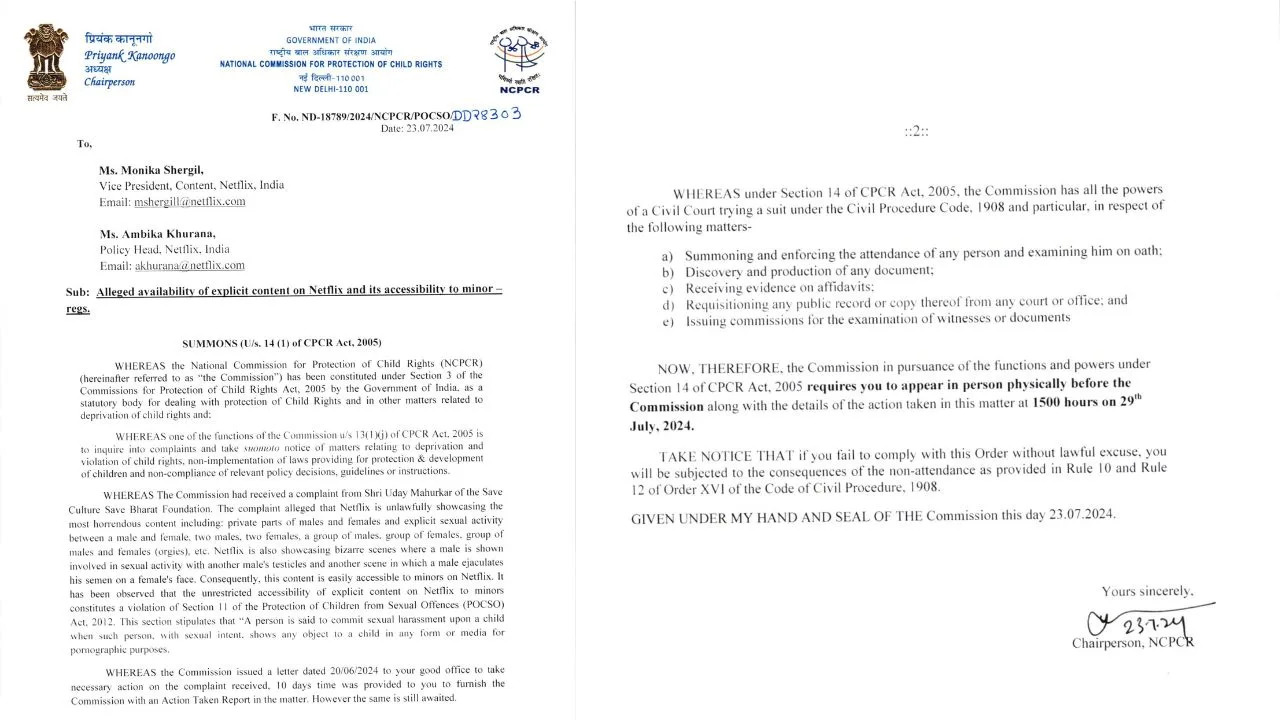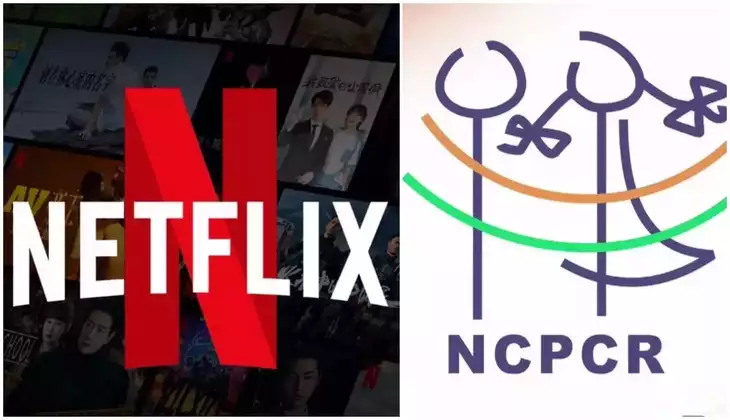On Tuesday, July 23, the National Commission for Protection of Child Rights (NCPCR) issued a summons to the OTT platform Netflix. The summons stated that Netflix was showcasing sexual content that minors could easily access, which is a violation of the Protection of Children from Sexual Offences (POCSO) Act, 2012.
The NCPCR mentioned that a letter had been sent to Netflix regarding this issue at the beginning of June, but no response was received. Netflix has not issued any statement in response to the new summons.
The Commission, under Section 14 of the CPCR Act 2005, has mandated that Netflix officials physically appear on July 29 at 3 PM, providing details of the steps they have taken to address this issue.
The complaint told NCPCR that Netflix is unlawfully showcasing the most explicit content, including private parts of males and females, and explicit sexual activity between a male and female, two males, two females, a group of males, a group of females, and group orgies involving both genders.
Additionally, Netflix is accused of featuring bizarre scenes where a male is shown engaging in sexual activity with another male’s testicles and another scene in which a male ejaculates his semen on a female’s face. This content is easily accessible to minors on Netflix, and the unrestricted accessibility of explicit content to minors is a violation of Section 11 of the Protection of Children from Sexual Offences (POCSO) Act, 2012.
This section states, “A person is said to commit sexual harassment upon a child when such person, with sexual intent, shows any object to a child in any form or media for pornographic purposes.”

Media reports indicate that from 2018 to 2024, many OTT platforms began presenting B-grade and low-budget soft porn content as web series. This led to the implementation of regulations for OTT platforms by the Supreme Court and Delhi High Court.
Currently, the government monitors the content of OTT platforms through the Intermediary Guidelines and Digital Media Ethics Code Rules, 2021.
These rules require OTT platforms to classify their content, provide age ratings, and adhere to self-regulation. If these requirements are not met, the government can block the objectionable content under Sections 67, 67A, and 67B of the Information Technology Act.
Notably, on January 10, the NCPCR summoned Mira Chatt, YouTube’s Head of Government Affairs and Public Policy in India, regarding certain videos on the platform that portray minors indecently.
The NCPCR chief expressed concern about an alarming trend of various challenges on YouTube that portray potentially indecent acts involving mothers and sons. “This raises serious concerns about the potential harm it could inflict on the child’s well-being and safety. These videos are also viewed by minors, which further raises significant concerns,” the letter from NCPCR stated.
Kanoongo asked Chatt to provide a list of all indecent challenges being run on YouTube “portraying potentially indecent acts involving mothers and sons,” as well as a list of channels on YouTube that promote such challenges involving minors.
According to reports, NCPCR has been monitoring the content on YouTube after a derogatory video of a mother and minor son was uploaded to the platform. The video quickly gained attention and went viral on other social media platforms.
The NCPCR believes that such content on YouTube is hazardous to the overall growth of minors and that this type of content should be monitored and dealt with seriously by the concerned authorities.
Netflix’s journey to success began in 2004 when its annual revenue reached Rs 3.73 thousand crores. This financial milestone significantly boosted the company’s popularity and subscriber base. By 2005, around 5 million people worldwide had subscribed to Netflix. However, YouTube, which also launched in 2005, posed a new challenge.
In response to YouTube’s rapid expansion, Netflix introduced video streaming on its app in early 2007. The app featured a “WATCH NOW” option, allowing users to watch their favourite movies without needing a DVD. This innovation was a game-changer for Netflix. The company subsequently made deals with Blu-ray and Xbox 360, allowing them to stream content on Netflix.
Initially, Netflix delivered DVDs to customers’ homes via courier and then transitioned to streaming movies and TV shows digitally.
The story of OTT’s inception in India began in 2008 with the launch of the first independent OTT platform, BigFlix, by Reliance Entertainment. In 2010, Digivive introduced India’s first OTT mobile app, nexGTv.
In 2013 and 2014, nexGTv became the first app to livestream IPL matches. In 2015, Hotstar (now Disney+ Hotstar) became the most popular OTT platform in India by streaming IPL live.
In 2013, apps like Ditto TV and Sony LIV were launched, offering streaming of shows aired on channels like Star, Sony, Viacom, and Zee. This allowed viewers to download these OTT apps on a large scale and watch their favourite shows anytime.
OTT platforms experienced significant growth during the COVID-19 pandemic. In the first three months of 2020, OTT platforms in India saw a 13 per cent increase in views compared to the last three months of 2019. During the first lockdown, ZEE5 saw an 80 per cent increase in subscribers, while Amazon Prime gained 67 per cent new users.
According to Invest India’s report, during the COVID-19 period, the time spent by users on OTT platforms like Amazon Prime, Netflix, and Disney+ Hotstar increased by 82.63 per cent. During the same period, the time spent by Indians on free access platforms like YouTube increased by 20.5 per cent.
However, apart from parental and user controls, there is no additional mechanism to prevent minors from accessing inappropriate content. The NCPCR’s move is against rising soft-porn culture and their accessibility to the minors.



















Comments